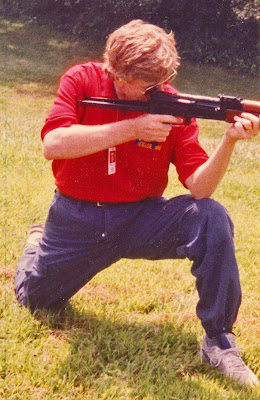On
the firing range at Mount Weather
The
FEMA facility, Mount Weather in Northern Virginia off Route 601, is where Vice
President Cheney sat out 9-11 underground.
Above ground, there is a shooting range and I went there to shoot an
AK-47 Assault Rifle – now some time ago.
This name, AK47, comes
from the second version of an assault weapon designed by Soviet Mikhail
Kalashnikov in 1947. When fired in
full-automatic mode, this AR fires continuously for every trigger pull. There have of course been design improvements
and model changes since its origin. The
magazine’s capacity is 30 rounds. It can
shoot 100 rounds a minute over an effective range of 400 meters.
You no doubt have seen
movie stars shoving fully loaded magazines in cinematic fight scenes. But loading the magazine beforehand is
something that has to be done carefully.
You place a round between the feed lips until it locks inside the
magazine, and you repeat this until the magazine is full. Like I said, 30 rounds. At the range, several of us loaded magazines for
each other before we shot.
When I was standing at
the firing line, the trigger felt sluggish and I didn’t fire. It didn’t feel right. The officer on the range said he didn’t see
anything wrong. But, because I was
persistent, we pulled out the magazine and one of the cartridges was nudging up
against another. The magazine had been
loaded wrong. The officer said, if
forced by the trigger pull, it could have exploded in hand. But, of course, that didn’t happen. We caught it.
You may know, if you’ve
ever fired one of these weapons, that it’s like a fire hose of lead running
from your hands through the slight recoil in your shoulder to the target,
almost like the target is pushing back – and then your magazine is spent – and
you load another.
We’ve had a lot of
pundits talk, with such bravado, about arming themselves, also teachers and janitors
with all manner of weapons but they never talk about jammed weapons, much less
how different it is to face a stationary paper target as opposed to someone who
surprises you in armor and is coming at you carrying an even more powerful
weapon than yours.
Perhaps this was best
brought home when Navy Seal Chris Kyle, 38, the world’s most renowned sniper,
who reportedly scored 150 combat kills, went to a rural Texas Shooting range
last week southwest of Fort Worth.
Mr. Kyle was armed but
he was shot dead by Eddie Ray Routh, a former Marine corporal, who served in
Iraq and who repeatedly shot and killed Kyle and Chad Littlefield, 35, with a
semiautomatic hand gun on the firing range.
Afterwards, Mr. Routh
said, Kyle and Littlefield “were out shooting target practice and he couldn’t
trust them so he killed them before they could kill him.”
This incident
underscores how difficult it is for even a trained assassin to defend himself
at a firing range. Yet some talk of math teachers and pastors packing heat in
schools, churches and homes.
Next up is how this was
a disaster waiting to happen. Early
reports informed us that the Marine corporal suffered from PTSD. If we hadn’t learned anything else, we would
think that inviting a serviceman with PTSD to a firing range was a really bad idea. If you haven’t read it, get a copy of
Jonathan Shay’s “Achilles in Vietnam: Combat Trauma and the Undoing of
Character.” It’s about this precise
question – how to help a returning vet with PTSD – and how the psychological
devastation of war has the same effect it has today as when Homer’s Iliad was first
created. Shooting ranges are not
recommended for recovery from PTSD.
We have since learned
that Mr. Hough was released from a Veterans hospital, from a psychiatric
center, over his parents’ objections, just four days before he gunned down Kyle
and Littlefield.
I agree there is some
right to arms in this nation but it is not a constitutional right separate from
the necessity of a militia.
Supreme Court Justice
Joseph Story wrote in his 1833 abridged edition of his treatise on the
Constitution how he lamented that, while “the importance of a well-regulated
militia would seem so undeniable, it cannot be disguised that among the
American people there is a growing indifference to any system of militia
discipline.”
Columbia Law Professor
Richard Uviller wrote more recently that, with the evaporation of state
militias all together, and their assumption into the Army, the Second
Amendment, as a matter of constitutional interpretation, had become a “vacant
and meaningless sequence of words.”
The Supreme Court appears to recognize a right
of privacy in the home. That’s what’s
left of the Court’s decision in Heller. But not much more. Beyond that, it is a right at common law and
circumscribed as any right, particularly given the mischief that weapons can
and have caused.
It is time we rolled up
our sleeves and defined what we will allow or not as our nation’s code of
violence – and not just with regard to arms.
The answer is most
certainly not a coterie of gun-slinging teachers and janitors in schools, not
when trained assassins can’t even defend themselves at a shooting range.
The answer is the rule
of law, not the code of the claw.


No comments:
Post a Comment